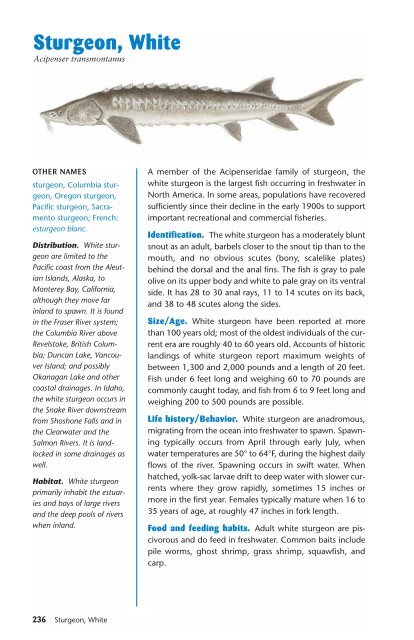Ken Schultz's Field Guide to Saltwater Fish - Macaw Pets store
Ken Schultz's Field Guide to Saltwater Fish - Macaw Pets store
Ken Schultz's Field Guide to Saltwater Fish - Macaw Pets store
Create successful ePaper yourself
Turn your PDF publications into a flip-book with our unique Google optimized e-Paper software.
Sturgeon, White<br />
Acipenser transmontanus<br />
OTHER NAMES<br />
sturgeon, Columbia sturgeon,<br />
Oregon sturgeon,<br />
Pacific sturgeon, Sacramen<strong>to</strong><br />
sturgeon; French:<br />
esturgeon blanc.<br />
Distribution. White sturgeon<br />
are limited <strong>to</strong> the<br />
Pacific coast from the Aleutian<br />
Islands, Alaska, <strong>to</strong><br />
Monterey Bay, California,<br />
although they move far<br />
inland <strong>to</strong> spawn. It is found<br />
in the Fraser River system;<br />
the Columbia River above<br />
Revels<strong>to</strong>ke, British Columbia;<br />
Duncan Lake, Vancouver<br />
Island; and possibly<br />
Okanagan Lake and other<br />
coastal drainages. In Idaho,<br />
the white sturgeon occurs in<br />
the Snake River downstream<br />
from Shoshone Falls and in<br />
the Clearwater and the<br />
Salmon Rivers. It is landlocked<br />
in some drainages as<br />
well.<br />
Habitat. White sturgeon<br />
primarily inhabit the estuaries<br />
and bays of large rivers<br />
and the deep pools of rivers<br />
when inland.<br />
236 Sturgeon, White<br />
A member of the Acipenseridae family of sturgeon, the<br />
white sturgeon is the largest fish occurring in freshwater in<br />
North America. In some areas, populations have recovered<br />
sufficiently since their decline in the early 1900s <strong>to</strong> support<br />
important recreational and commercial fisheries.<br />
Identification. The white sturgeon has a moderately blunt<br />
snout as an adult, barbels closer <strong>to</strong> the snout tip than <strong>to</strong> the<br />
mouth, and no obvious scutes (bony, scalelike plates)<br />
behind the dorsal and the anal fins. The fish is gray <strong>to</strong> pale<br />
olive on its upper body and white <strong>to</strong> pale gray on its ventral<br />
side. It has 28 <strong>to</strong> 30 anal rays, 11 <strong>to</strong> 14 scutes on its back,<br />
and 38 <strong>to</strong> 48 scutes along the sides.<br />
Size/Age. White sturgeon have been reported at more<br />
than 100 years old; most of the oldest individuals of the current<br />
era are roughly 40 <strong>to</strong> 60 years old. Accounts of his<strong>to</strong>ric<br />
landings of white sturgeon report maximum weights of<br />
between 1,300 and 2,000 pounds and a length of 20 feet.<br />
<strong>Fish</strong> under 6 feet long and weighing 60 <strong>to</strong> 70 pounds are<br />
commonly caught <strong>to</strong>day, and fish from 6 <strong>to</strong> 9 feet long and<br />
weighing 200 <strong>to</strong> 500 pounds are possible.<br />
Life his<strong>to</strong>ry/Behavior. White sturgeon are anadromous,<br />
migrating from the ocean in<strong>to</strong> freshwater <strong>to</strong> spawn. Spawning<br />
typically occurs from April through early July, when<br />
water temperatures are 50° <strong>to</strong> 64°F, during the highest daily<br />
flows of the river. Spawning occurs in swift water. When<br />
hatched, yolk-sac larvae drift <strong>to</strong> deep water with slower currents<br />
where they grow rapidly, sometimes 15 inches or<br />
more in the first year. Females typically mature when 16 <strong>to</strong><br />
35 years of age, at roughly 47 inches in fork length.<br />
Food and feeding habits. Adult white sturgeon are piscivorous<br />
and do feed in freshwater. Common baits include<br />
pile worms, ghost shrimp, grass shrimp, squawfish, and<br />
carp.


